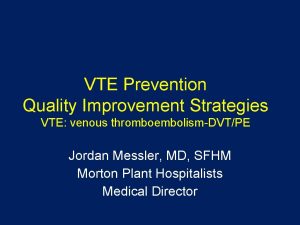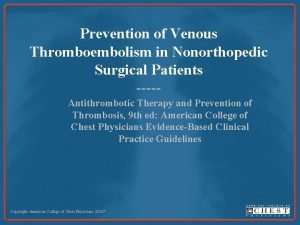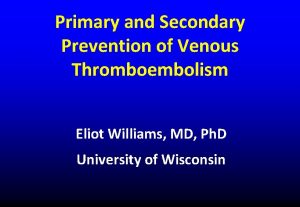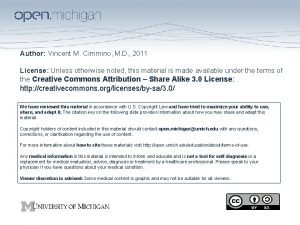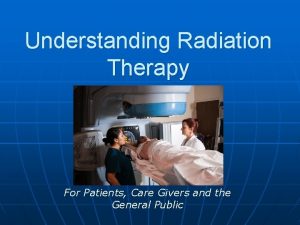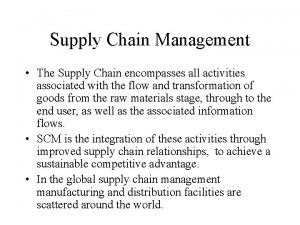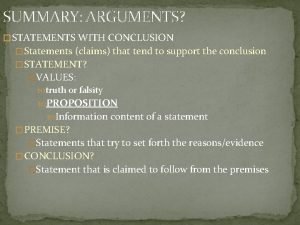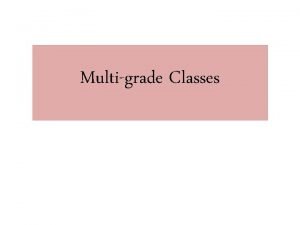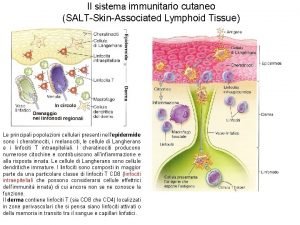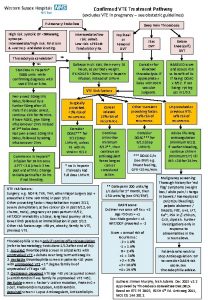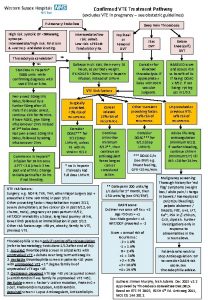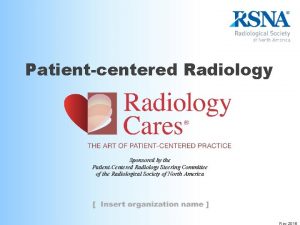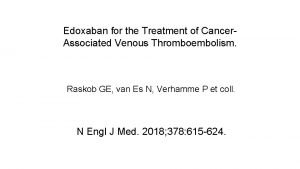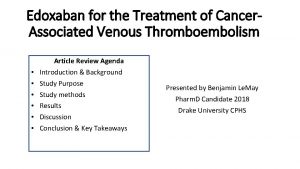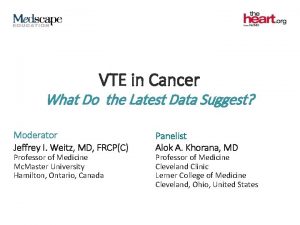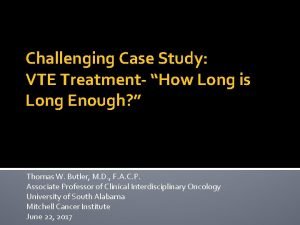Patientcentered treatment of cancer associated VTE Does one






























- Slides: 30

Patient-centered treatment of cancer associated VTE. Does one size fit all? Simon Noble Clinical Professor in Palliative Medicine Cardiff University




Management of CAT • Should be guided by best available evidence • Where evidence lacking management should be guided by an appreciation of – Pathophysiology of CAT – Thrombogenicity of respective cancer – Thrombogenicity of respective chemotherapy – Bleeding risks – Patient views

Schön’s swamp

Factors in decision making Heuristics Evidence Patient preference

Heuristics • Simple, efficient rules which people often use to form judgments and make decisions – “rule of thumb” – Mental shortcuts

Heuristics • Simple, efficient rules which people often use to form judgments and make decisions – “rule of thumb” – Mental shortcuts • May be prone to bias – Availability – Representativeness – Anchoring and adjustment

Availability • The ease with which a particular idea can be brought to mind. • When considering likelihood of something happening we are often using availability heuristic • When considering infrequent events we may overestimate outcome likelihoods

The heterogeneity of Elvis Presley

Areas of uncertainty • Anticoagulation beyond 6 months in patients with active cancer • Within populations omitted from clinical trials – Extremes of weight – Brain metastases – Bleeding – Poor prognosis – Poor performance status • Choice of anticoagulant: LMWH vs coumarin vs DOAC

Clinical decision making in the swamp • Appreciation of the data in the less representative population • Appreciation of the heterogeneity of cancer • Discussion with patients regarding their wishes

The CLOT Trial Primary outcome: VTE recurrence Risk reduction = 52% HR 0. 48 (95% CI 0. 30, 0. 77) NNT = 13 log-rank p = 0. 002 HR = hazard ratio; NNT = number needed to treat; VKA = vitamin K antagonist; VTE = venous thromboembolism Lee AY et al. N Engl J Med 2003; 349(2): 146‒ 153.

LMWH vs warfarin meta analysis

WHAT ABOUT DOACS?

DOACs in the treatment of CAT Recurrent VTE Pooled incidence rates: 4. 1% (2. 6– 6. 0) for DOACs 6. 1% (4. 1– 8. 5) for VKAs [RR 0. 66 (0. 38– 1. 2)] Recurrent VTE warfarin Lee A et al. 2003: 16% Meyer G et al. 2002 17% Major bleeding or CR-NMB 17 van der Hulle T et al. J Thromb Haemost 2014. CRNMB = clinically-relevant non-major bleeding

Proportion of metastatic patients STUDY LMWH WARFARIN CLOT 66% 69% LITE 47% 36% CATCH 55% 54% ONCENOX 54% 52% EINSTEIN DVT/PE 26% RIVAROXABAN 19%

Initial treatment of CAT Heuristics Evidence Patient preference

Initial treatment of CAT Heuristics H W M LEvidence Patient preference

Treatment beyond six months Heuristics Evidence Patient preference

Factors influencing decision whether to extend anticoagulation in CAT Favors continuing anticoagulation Factor Favors stopping anticoagulation Patient preference • 10 concern recurrence • 10 concern hemorrhage Malignancy specific • Active malignancy • High risk cancer e. g. , lung • Ongoing chemo or ESA • No evidence of disease • Low risk cancer e. g. , breast Previous history of VTE • Yes • No Nature of initial VTE • Life-threatening PE • DVT with severe postphlebitic syndrome • Non life-threatening PE • No residual symptoms Risk of hemorrhage • No • Yes Additional risk factors • • Obesity Sex Poor performance status Central venous catheter • Risk factors other than malignancy when diagnosed e. g. , surgery 10 = primary; CAT = cancer-associated thrombosis; DVT = deep vein thrombosis; ESA = erythropoiesis stimulating agent; PE = pulmonary embolism 22 Zwicker JI, Bauer KA. J Clin Oncol 2014. 32(32): 3596– 3600.

Treatment beyond six months Heuristics H W LM A K V C Patient A Evidence O D preference

Recurrent VTE management Heuristics Evidence Patient preference

Treatment beyond six months Heuristics Evidence Patient preference

Treatment beyond six months Heuristics EMPIRICAL INCREASE LMWH BD DOSING Anti-Xa monitoring Evidence Patient preference

End of life Heuristics Evidence Patient preference

Interference with cancer treatment is the most important attribute to patients, followed by efficacy of VTE therapy n = 100 * Impact / weight of each attribute on the overall preference / choice behavior

To conclude • • Strong evidence for LMWH in first 3 -6 months Data limited beyond that Several options available Our decisions need to be carefully considered and made in partnership with the patient

Thank You THANK YOU
 Vte protocol
Vte protocol Prevention of vte in nonorthopedic surgical patients
Prevention of vte in nonorthopedic surgical patients Recurvte
Recurvte Vte safety zone
Vte safety zone Treatment of inflammatory breast cancer
Treatment of inflammatory breast cancer Radiation therapy side effects
Radiation therapy side effects One weakness associated with the entity theory is that
One weakness associated with the entity theory is that One empire one god one emperor
One empire one god one emperor One one one little dog run
One one one little dog run One king one law one faith
One king one law one faith One empire one god one emperor
One empire one god one emperor Ford one plan
Ford one plan See one do one teach one
See one do one teach one One price policy
One price policy Night structure
Night structure See one do one teach one
See one do one teach one Asean tourism strategic plan
Asean tourism strategic plan Graphic organizer with the aims of la liga filipina
Graphic organizer with the aims of la liga filipina Does dale renlund have cancer
Does dale renlund have cancer Yash pal committee report 1993
Yash pal committee report 1993 What is massive igneous rock
What is massive igneous rock Psychodynamic theory is most closely associated with
Psychodynamic theory is most closely associated with What encompasses all activities associated with the flow
What encompasses all activities associated with the flow Implicit inferential claim
Implicit inferential claim Stigma associated with failure and repetition is removed
Stigma associated with failure and repetition is removed Salt skin associated lymphoid tissue
Salt skin associated lymphoid tissue England's national flower
England's national flower Job description of disbursing officer
Job description of disbursing officer Colors associated with time
Colors associated with time Idpe process
Idpe process Cerebral aqueduct
Cerebral aqueduct
